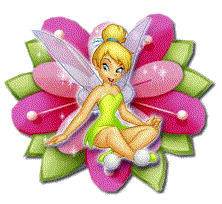MAY 2009
Featured Category
Bring May Flowers! By Alice Bell
CDHM Asst Editor
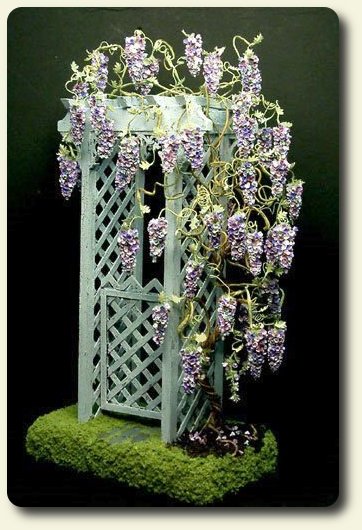
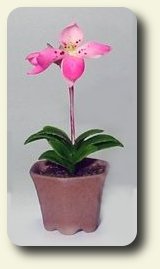 April showers bring May flowers just as surely as rice paper and tape bring mini blooms to life.
April showers bring May flowers just as surely as rice paper and tape bring mini blooms to life.
"Whether you're making a great yard or an arrangement I think in spring time you have to bring the tenderness of the season to your piece. For example using cherry blossom bunches, forgot-me-not, pussy willow and my favorite, weeping heart. But also tulips, narcissus and pansies," said Jeannette Buchholz, whose mini gardening abilities stemmed from one delphinium.
Real flowers should play a huge part in the mini florist's work.
"Before retirement, I had my own greenhouse. Then we "full timed" around the country in our motor home doing shows and sight-seeing for five years before settling down again. I was an avid "flower lover" who had been a miniaturist for years, so I guess it was just natural that I combined the two when I could no longer 'garden' in real life. I started by making some miniature flowers to put in a wall hanging "flower shop" and I guess I fell in love with the process!" said Era Anderson Pearce.
For Pim Sukkerd, it was creating that perfect bonsai that brought about the discovery of mini growing.
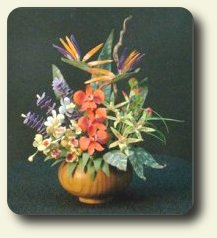 "I wanted a flowering Cherry Blossom tree. I love flowering trees because they are so beautiful and Cherry Blossom is one of my favorites. I had thought of that for a long time but didn't try to make one until I saw an amazingly realistic Bonsai made from clay," explained Pim.
"I wanted a flowering Cherry Blossom tree. I love flowering trees because they are so beautiful and Cherry Blossom is one of my favorites. I had thought of that for a long time but didn't try to make one until I saw an amazingly realistic Bonsai made from clay," explained Pim.
Several months and several hundred five-petal flowers later a few Cherry Blossom trees were "alive" and well.
"They were not as beautiful as I wanted, but did make me proud. After that, I made mini flowers/plants from air-dry clay, in 1:6 and 1:9 scale. Now I focus on 1:12 smaller and am starting to make flowers/plants from baking clay as well. It's a new challenge," declared Pim.
Becoming a miniature gardener can be that simple, if practice, practice, practice can be called simple.
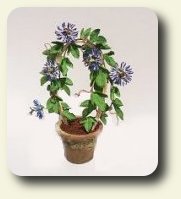 "I started with a single delphinium, very different from the one I'm doing today. But from that very first flower I was fascinated with this material, so I learned more and more," said Jeannette.
"I started with a single delphinium, very different from the one I'm doing today. But from that very first flower I was fascinated with this material, so I learned more and more," said Jeannette.
"Study good pictures and try to duplicate real flowers. Always use good materials and supplies. Accurate tools are important, such as a stylus for shaping, and good brushes for painting, sharp scissors, a needle tool and of course very fine tweezers," said IGMA Fellow Pearce.
"Have patience, always study your "imperfect" specimens to see what you can improve and then throw them away. Don't mistake the words 'perfect' and 'realistic' as meaning the same thing. 'Realistic' flowers are not necessarily 'perfect' as they have natural flaws such as weather or age damage. Remember that any accomplished flower maker got there only through practice, practice, practice and don't let anyone try to tell you different!" said Era.
"Look at your favorite plant. The more we look the more we like, and the greater the desire to make them. Materials, tools and supplies are abundant, information is easy to find in magazines, books and the internet," advised Pim.
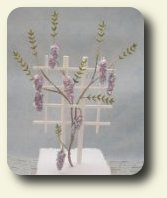 "If someone were new to tiny flowers, I would advise starting with a kit which is easy to follow. Ruth Hanke is selling many of them so the beginner gets a feeling for the work. A great help is to have the real plant on the table or have good pictures" said Jeannette.
"If someone were new to tiny flowers, I would advise starting with a kit which is easy to follow. Ruth Hanke is selling many of them so the beginner gets a feeling for the work. A great help is to have the real plant on the table or have good pictures" said Jeannette.
"Don't forget originality, design and scale is of utmost importance! Going the "extra mile" to create realism through detail is what it is all about. Thorough research is a necessity, and details like hand cutting, accurate painting and realistic shading are the things that really give life to any miniature flower arrangement, garden or setting," advised Era.
"I am not very good at gardening and arranging flowers," Pim admitted. "I think basic knowledge of flowers and plants is important, but creativity and the ability to imagine the completed work are very important in making your creation a work of art or just an ordinary work. Materials and supplies are important too, but I believe anything can be turned into a masterpiece as long as the imagination and creativity is there to make your pieces great."
Greatness can be found in the materials, or sometimes just in the fingers that wield them.
"I use Luna Clay (air-dry) and simple tools; such as tiny pins, tiny drumbels, tweezers and sharp scissors for hand-sculpted flowers. I also use pasta machine and custom-made cutters for leaves and flower petals. More often, I just use my hands," said Pim.
"All of my materials are imported directly from Japan: handmade "silk linen" or "cotton crepe" paper or the thinnest of rice papers for all petals and leaves, and I use only the finest Japanese paper covered floral wire because it makes the construction so much easier! As far as flower centers, etc., are concerned I try to remember that it is the 'illusion' that I am after, so I use just about whatever material necessary that will help me create that illusion," said Era.
"I use everything that brings me the result of a realistic flower. I handcut, use lasercuts and tiny punched petals," added Jeannette.
Visit the Indoor/Outdoor Landscaping Galleries to see all the wonderful flowers and trees.
Custom Dolls, Houses & Miniatures / CDHM




